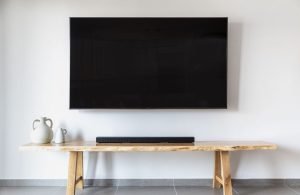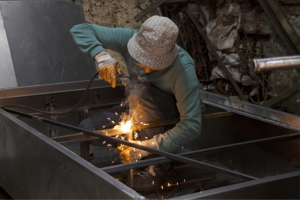Last Updated on October 21, 2025 by teamobn
Although keeping boots neat in limited areas might be difficult, the correct storage options can make a big difference. Strategic boot racks not only save space but also help your house to seem neat and fashionable from doors to closets. You may utilize every inch of your living space by using imaginative solutions such as under-bed storage, wall-mounted racks, or multifunctional furniture. These clever ideas will enable you to choose the ideal boot storage solution catered to your area of living and usage.
Contents
Boot Rack Ideas Basics
Boot racks are more than just practical storage solutions; they are essential for keeping your home organized and clutter-free. Boots, especially taller ones, can be difficult to store properly without a designated space. A boot rack helps prevent unsightly piles of footwear and ensures your boots remain in excellent condition by offering proper support and ventilation.
This is particularly important for preserving leather and other delicate materials, as improper storage can lead to creasing, cracking, or mold buildup. By using a boot rack, you can protect your investment and extend the lifespan of your favorite footwear.
Beyond functionality, boot racks add an element of style and convenience to your home. Many designs are crafted with aesthetics in mind, blending seamlessly into modern, rustic, or minimalist interiors. Compact and versatile options can fit into small spaces like entryways, closets, or under furniture, making them ideal for any living arrangement.
With customizable and DIY options available, you can create a boot rack that complements your home decor while addressing your storage needs. Incorporating a boot rack into your home is a small change that delivers a significant impact, keeping your space tidy and enhancing its overall appeal.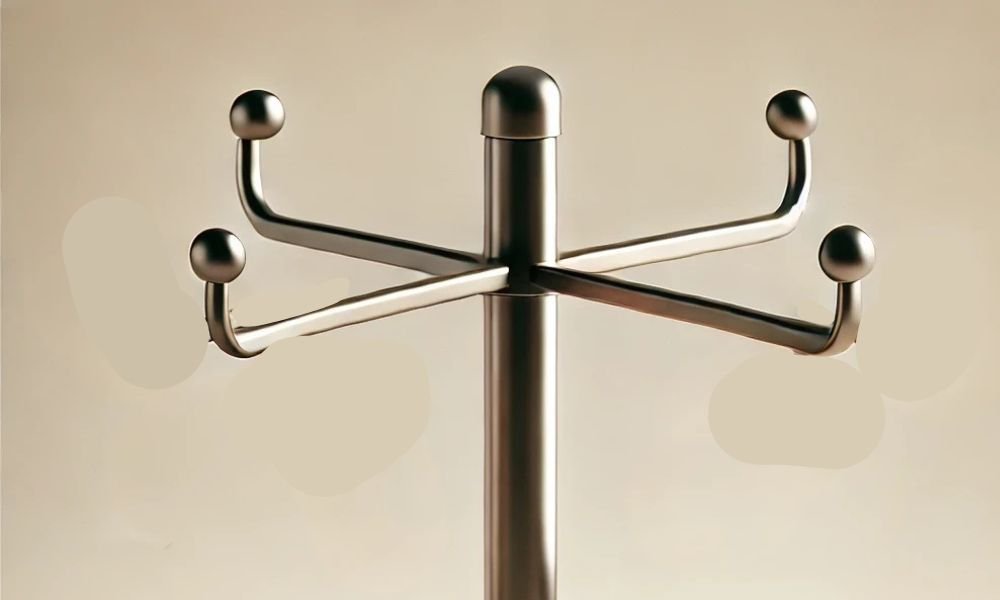
Building Sturdy Boot Rack Ideas
Are you tired of tripping over boots cluttering your entryway? Building a DIY boot rack is a practical solution. With just a few materials and tools, you can create a functional and stylish rack. Follow these step-by-step instructions.
If you’d like a visual guide that mirrors this simple, space-saving design, check out this step-by-step DIY boot rack tutorial for detailed measurements and build photos.
Tools:
- Circular saw (or handsaw)
- Drill/driver with bits
- Tape measure
- Sandpaper (medium and fine grit)
- Clamps
Materials:
- (1) 1x6x8 board (for the base)
- (2) 1x2x8 boards (for supports and crossbars)
- 1 ¼″ wood screws
- Wood glue
- Wood filler (optional, for covering screw holes)
- Paint or stain (optional)
Steps
Step 1: Prepare the Wood
Cut the following pieces:
- Base: (1) piece of 1×6 at 36 inches
- Vertical supports: (2) pieces of 1×2 at 30 inches
- Crossbars: (4) pieces of 1×2 at 18 inches each Sand all pieces to smooth rough edges and surfaces.
Step 2: Attach Vertical Supports
Position the two 30-inch vertical supports upright at either end of the 36-inch base. Secure them with wood glue and screws. Use clamps to hold the pieces in place while drilling pilot holes and inserting screws for a snug fit.
Step 3: Install Crossbars
Evenly space the 18-inch crossbars between the two vertical supports. Attach them with wood glue and screws, ensuring they are level. These crossbars will hold the boots. Aim for 6–8 inches between each bar.
Step 4: Reinforce the Structure
Attach a horizontal brace across the back of the supports for added stability. Cut a scrap piece of 1×2 to 33 inches and secure it across the back with screws and wood glue.
Step 5: Sand and Finish
Give the entire rack another round of sanding for smoothness. If desired, fill screw holes with wood filler and let it dry. Apply paint or stain to protect the wood and match your décor. Allow to dry completely.
Step 6: Organize Your Boots
Place the rack in a convenient spot and hang your boots on the crossbars. This design works well for keeping boots upright, organized, and aired out.
With this alternative method, you’ll create a functional boot rack using different tools and materials.
Creative Boot Rack Ideas
Using pegs to hang boots is a functional and visually appealing option. Here are five unique boot rack designs to inspire your next DIY project. Each design can be customized to fit your space and style.
Wall-Mounted Peg Rack
A wall-mounted peg rack is a simple yet effective solution for organizing boots while keeping your floor space clear. Start by selecting a sturdy wooden board or a pre-made shelf that can support the weight of the boots. Measure and mark evenly spaced points where the pegs will be installed. Use wooden dowels or metal hooks as pegs, ensuring they are long enough to securely hold a pair of boots. Drill holes at the marked points, insert the pegs, and secure them with wood glue or screws.
For added customization, you can paint the board in a color that complements your room or stain it for a more natural, rustic look. This design works particularly well in narrow entryways or mudrooms with limited floor space. Mount the rack at a height that allows boots to hang freely without touching the ground, keeping them organized and easy to access.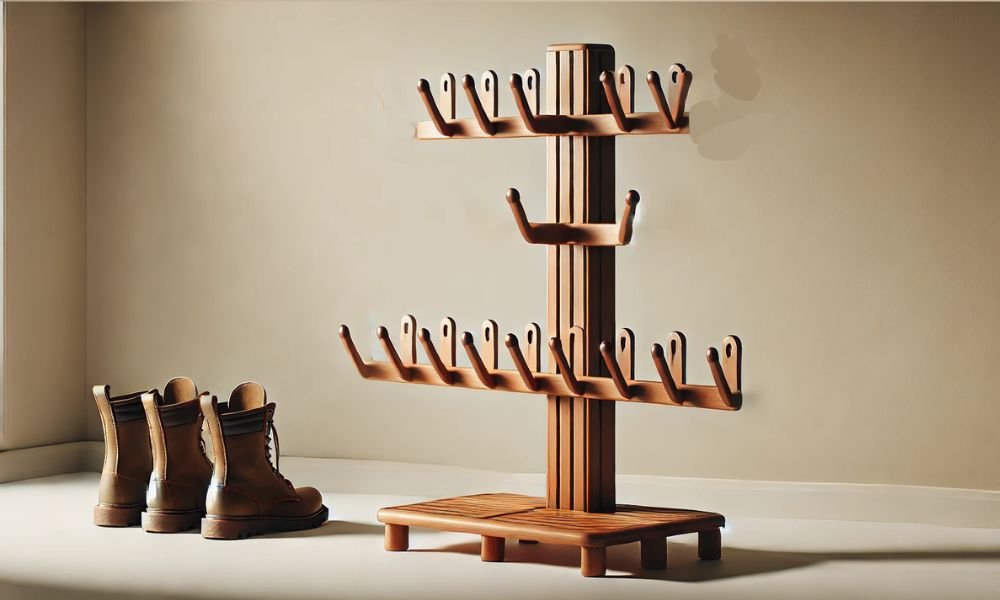
Freestanding Peg Rack
A freestanding peg rack is a versatile and mobile option for boot storage. Start by constructing a frame using two vertical posts as the main supports. These posts should be tall enough to accommodate multiple rows of pegs for different boot heights. Connect the vertical posts with horizontal bars at the top and bottom to form a sturdy frame. Attach pegs or dowels to the vertical posts, spacing them strategically at varying heights to fit different types of boots.
To ensure the rack remains stable, build a wide base or include cross-bracing at the bottom. This prevents tipping, even when the rack is fully loaded. A freestanding design is ideal for renters or those who prefer not to drill into walls, and it can easily be moved to different rooms or even outdoors for cleaning. Add a protective finish to the wood to enhance durability and make the rack more resistant to moisture, ensuring it lasts for years.
Peg and Shelf Combo Rack
The peg and shelf combo rack merges practicality and style, offering dual-purpose storage for boots and other essentials. To create this design, start with a sturdy board for the base and another for the shelf. Install a row of pegs below the shelf for hanging boots, ensuring the spacing between pegs allows boots to hang freely without crowding. Use wood glue and screws to securely attach the pegs and the shelf to the baseboard.
The shelf can be positioned above the pegs to hold items like gloves, hats, or scarves, making it a convenient spot for all your entryway necessities. For additional strength, add brackets beneath the shelf. This hybrid design is ideal for small spaces as it maximizes vertical storage, keeping your floor clear and your items easily accessible. Customize the rack with paint or stain to match your décor, and consider adding hooks on the sides of the board for extra functionality.
Rotating Peg Rack
The rotating peg rack is a clever and efficient solution for households with multiple pairs of boots. Begin by constructing a central pole from a thick wooden dowel or metal rod. Secure the pole to a sturdy base to ensure stability, using a heavy wood block or metal plate as the foundation. Create circular tiers from plywood or MDF, and drill evenly spaced holes around the edges of each tier for the pegs.
Insert pegs securely, ensuring they are long enough to hold boots. Stack the tiers along the central pole, spacing them to accommodate boots of varying heights. To enable rotation, install a lazy Susan bearing between the base and the bottom tier. This allows the entire rack to spin, making it easy to access any pair of boots without moving the rack. Finish the design with paint or a sealant for durability. This design is perfect for large families or shared living spaces, providing ample storage in a compact footprint.
Minimalist Peg Ladder
A minimalist peg ladder combines simplicity and functionality, making it an elegant addition to any space. Start with a pre-made wooden ladder or build one from scratch using two vertical wooden posts and evenly spaced horizontal rungs. Attach pegs or wooden dowels to each rung at a slight upward angle to prevent boots from slipping off. Secure the ladder by leaning it against a wall, or fix it in place with brackets for added stability.
This design is ideal for narrow spaces and offers a modern aesthetic. The vertical structure keeps boots organized and off the floor, making cleaning the area a breeze. You can sand and stain the wood for a natural finish to enhance its look or paint it to complement your room’s décor. Add small hooks to the side rails for hanging smaller items like keys or accessories, increasing the ladder’s utility. This simple yet stylish design fits seamlessly into both rustic and contemporary interiors.
These peg-based boot rack ideas are versatile, space-efficient, and easy to customize. Choose one that fits your needs and organize your boots in style.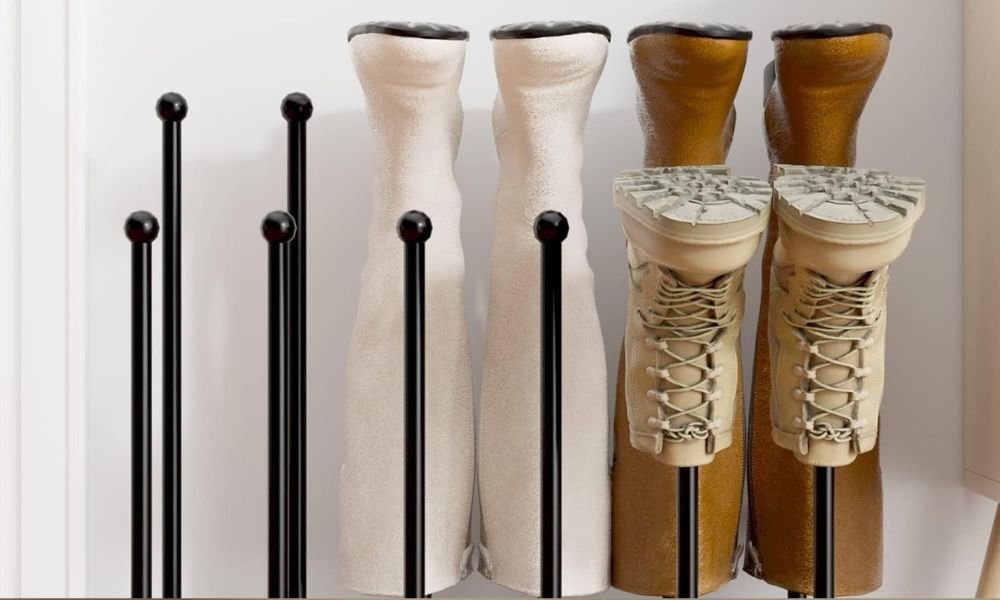
Best Materials for Durable Boot Racks Ideas
Boot racks are essential for keeping your footwear organized, but their durability depends largely on the materials they are made from. Choosing the right material ensures your boot rack can handle heavy-duty use, maintain its aesthetic appeal, and protect your boots from wear and tear. Whether you’re purchasing a pre-made rack or building your own, understanding the pros and cons of different materials can help you make the best choice for your needs.
Wood
Wooden boot racks are a classic choice due to their natural aesthetics and sturdy construction. They blend well with most home decor styles, from rustic to modern. Popular woods like pine, oak, and walnut offer durability and can support the weight of multiple pairs of boots.
Pros:
- Long-lasting with proper care
- Customizable with paint or stain
- Adds warmth and elegance to any space
Cons:
- Susceptible to moisture damage without treatment
- May require regular maintenance like sanding or sealing
Best Use Cases:
Wooden boot racks work well in indoor spaces like closets or entryways where moisture exposure is minimal. Opt for treated wood if the rack will be in a mudroom or other high-moisture area.
Metal
Metal boot racks, typically made from stainless steel or iron, are known for their strength and modern appeal. They are ideal for heavy boots, as the material can support significant weight without bending or breaking.
Pros:
- Extremely durable and long-lasting
- Resistant to wear and tear
- Easy to clean
Cons:
- Can be prone to rust if not coated or treated
- May lack the warmth of other materials
Best Use Cases:
Metal boot racks are excellent for garages, entryways, or outdoor spaces. Look for powder-coated finishes to prevent rusting and maintain their sleek appearance.
Plastic
Plastic boot racks are lightweight, cost-effective, and easy to maintain. They are often used for temporary or seasonal storage and come in a variety of designs and colors to suit different needs.
Pros:
- Resistant to moisture and easy to clean
- Lightweight and portable
- Budget-friendly
Cons:
- Less durable than wood or metal
- May not support heavy boots over time
Best Use Cases:
Plastic racks are ideal for kids’ rooms, temporary boot storage, or outdoor use in sheltered areas. They’re a good option if you need something quick and inexpensive.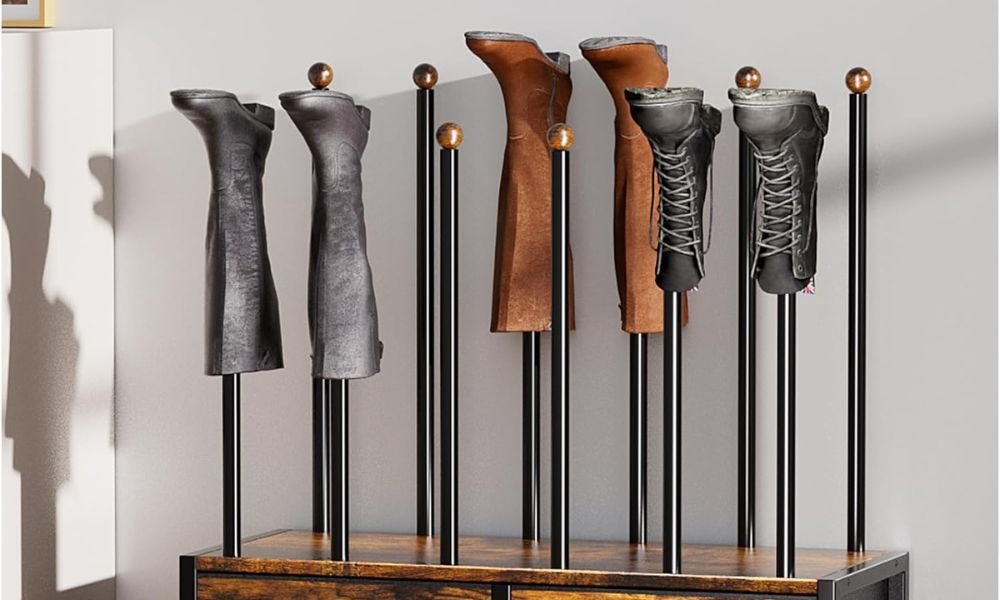
Bamboo
Bamboo is an increasingly popular material for boot racks due to its eco-friendly nature and aesthetic appeal. It’s both lightweight and surprisingly strong, making it a versatile option for boot storage.
Pros:
- Sustainable and environmentally friendly
- Resistant to moisture when treated
- Lightweight yet sturdy
Cons:
- May require additional treatment to enhance durability
- Limited weight capacity compared to metal
Best Use Cases:
Bamboo boot racks are great for indoor spaces like bedrooms or entryways. Choose a treated bamboo rack to ensure it can withstand occasional moisture exposure.
PVC
PVC pipes are a DIY favorite for creating customizable boot racks. They are highly durable, waterproof, and easy to assemble into creative designs that suit your specific needs.
Pros:
- Waterproof and resistant to corrosion
- Easy to cut and assemble for DIY projects
- Lightweight and low maintenance
Cons:
- Less aesthetic appeal unless customized
- Limited weight capacity
Best Use Cases:
PVC boot racks are perfect for mudrooms or garages where functionality takes precedence over style. They’re also an excellent option for seasonal storage.
Fabric
Fabric organizers, often featuring compartments or hanging pockets, provide a flexible and space-saving solution for boot storage. They are great for lightweight boots and areas with minimal floor space.
Pros:
- Lightweight and easy to store when not in use
- Affordable and versatile
- Soft material prevents scratches
Cons:
- Limited durability for heavy or wet boots
- Requires regular cleaning to avoid dust and mold
Best Use Cases:
Fabric boot racks are ideal for closets or behind doors, where space is limited. They work best for lightweight or dress boots rather than heavy-duty footwear.
How to Choose the Right Material for Your Boot Rack
When deciding on a material, consider the following factors:
- Durability Needs: If your boots are heavy or frequently used, opt for stronger materials like metal or treated wood.
- Moisture Resistance: For outdoor or damp areas, materials like metal with a rust-resistant finish or PVC are ideal.
- Aesthetic Preferences: Wood and bamboo offer natural beauty, while metal provides a sleek, industrial look.
- Budget: Plastic and fabric are budget-friendly options, while wood and metal may require a larger investment.
Choosing the right material for your boot rack is essential to ensure durability, functionality, and style. Whether you prioritize strength, affordability, or environmental friendliness, there’s a material suited to your needs. By understanding the benefits and drawbacks of each option, you can select a boot rack that will keep your footwear organized and your space looking its best for years to come.
Conclusion
Boot racks are a practical and stylish way to keep your footwear organized and protected. With so many options available, you can find a solution that fits your space and complements your home decor. Choosing the right design and material ensures your boots stay in great condition while maximizing storage efficiency.
We have more storage solutions for your footwear. Read our list of smart shoe storage projects!




